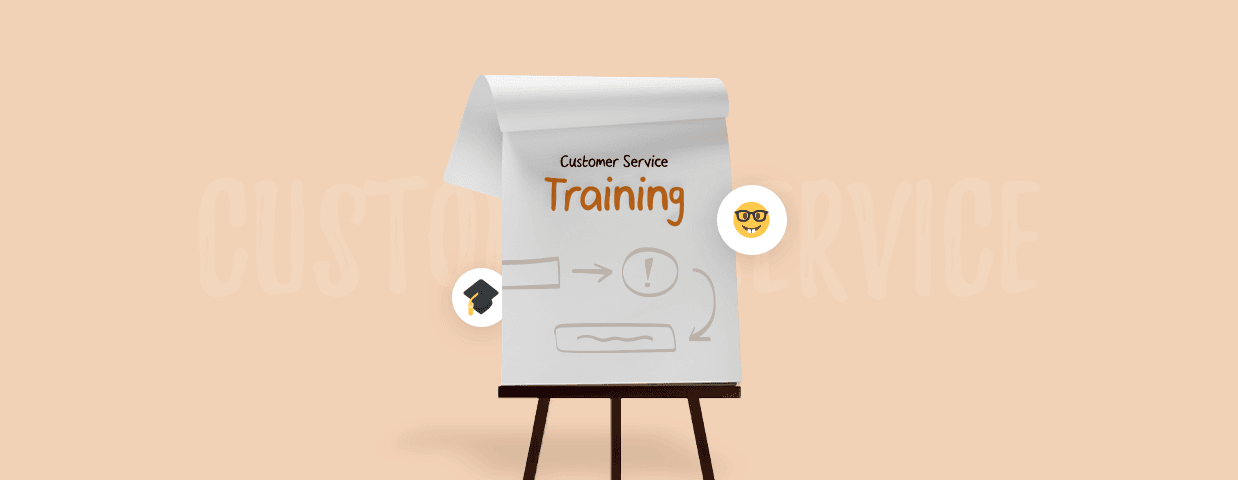Customers know that excellent service is something they are entitled to.
So if you don’t take good care of them, someone else will.
This is why improving the skills of your employees should be an ongoing operation. There is never too much training for customer service and support.
But how to make the most of it? And how to transform customer support training into a fixed part of your company’s culture?
This article covers:
- Essential service skills that you can develop through training
- Best service training ideas that are easy to organize in-house
- Role-playing scenarios for your own practice
- Top customer service courses and programs
- Selection of quality customer training manuals and other materials
If you are interested in more general topics related to customer service, you can also check out:
- How to Handle Customer Complaints Like a Pro
- 6 Steps to Measure Customer Satisfaction
- Customer Success [Metrics, Stories, & More]
- 7 Ways to Deliver Good Customer Service [With Examples]
- 13 Top Customer Success Interview Questions & Answers
Your customer service team can also learn by practice. Here is a useful customer service training software that is completely free.
Learn how to use AI chatbots to boost your sales
What is customer service training all about?
Customer service training is about improving your employees’ core service skills. It refers to product knowledge, soft skills, and interpersonal competencies. Meeting customer expectations and increasing their satisfaction are the goals of such training.
The actual training comes in all shapes and sizes. Some of the most popular options are:
- Online customer service courses
- Webinars and QA sessions
- In-person service training workshops
- Customer service training manuals and ebooks
Customer training: soft skills vs hard skills
Soft skills may include personal work ethics or good time management. Soft skill training sessions for customer service are fun and easy to organize. However, agents should be equipped with hard skills too. Technical qualifications and in-depth knowledge are essential for some customer service jobs. Remember about product training as well.
Why is customer support training so important?
Some customer service training seminars are quite costly. The average cost for training an employee usually varies between $500 and $1,500. Also, training sessions can last up to several weeks.
So—
Why would an employer encourage an employee to complete a customer service training class?
First of all, reducing customer churn is one of the most important business priorities right now. And, according to a report by Oracle, 73% of customers remain loyal because of positive interactions with customer support. In other words, training your team has a direct impact on customer retention.
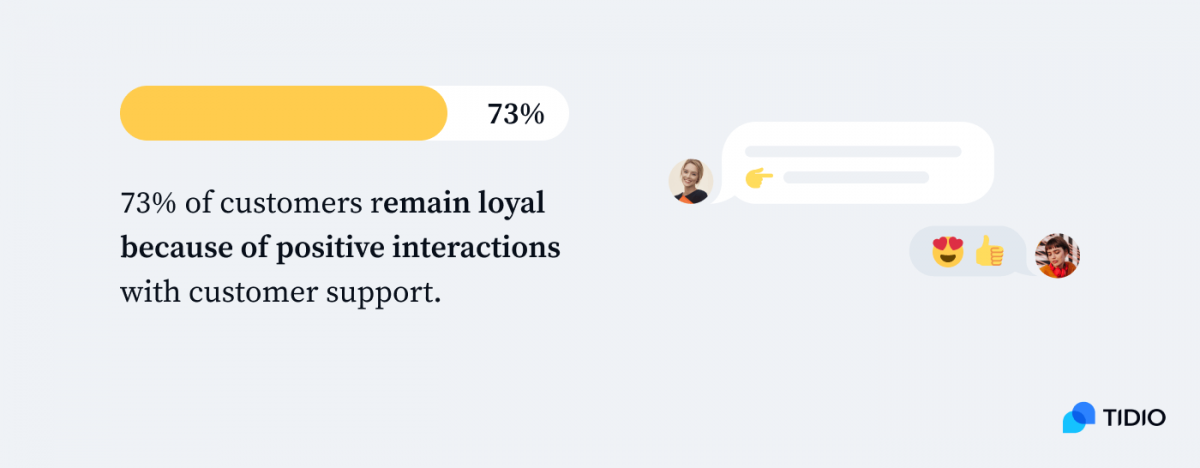
Being on par in terms of price and quality only gets you into the game. Service wins the game

However, customer service is not a natural chat between individuals. It has some unique quirks and very specific dynamics. Even very communicative and empathic people can make mistakes. Without realizing it!
For example, not being judgmental is one of the most important rules of good service.
An agent shouldn’t say that something is good, bad, right, or wrong. Especially, if it goes against what the customer is saying. If a guest tells you that their Wi-Fi is slow, you should never ever say anything like “Well, actually it’s not that bad.”
The customer isn’t always right. But they should feel like they are and that you are doing everything to help them out. Otherwise, you will just waste time arguing over things that are beside the point. Winning an argument means losing a customer. You should always try to put the needs of customers above your own. It’s called customer orientation.
Is customer service training really necessary?
Some people may be natural born customer service agents But most customer service representatives will need to work hard to get there. Excellent customer service skills can be acquired through training and practice and customer service skills training is very much like a regular workout.
Essential areas of customer service training with easy exercises
What are the objectives of customer service training? The ultimate objective is to make customers more satisfied. But to do this, your employees need to learn the following customer service skills:
1. Bringing positive attitude
A simple smile can be the biggest asset of your customer service team members. It doesn’t mean that you need to be chirpy or grinning like a madman. But keeping a positive attitude is an essential part of the job.
You are serving a customer, not a life sentence. Learn how to enjoy your work.

The attitude of your customer service reps speaks volumes about your brand. Your customer service training should cover aspects such as posture, language, and tone of voice. They all give small hints about the attitude of your agents. And the energy that your agents radiate is contagious! Make sure that it is not negative.
Customer service training exercise:
- A customer wants to get a refund. However, he is not eligible for it. Try to explain it to him without forming negations like “don’t/won’t/not.” Try to end on a positive note.
Read more: 7 Tips for Maintaining A Positive Attitude in Customer Service
2. Listening to customers
Most people think of themselves as good listeners. But customer service requires a special kind of skill called active listening. It isn’t just about being quiet and allowing someone to talk. Active listening uses conversation techniques that keep both parties engaged.
Trained customer service agents know how to reply, paraphrase, and ask follow-up questions. Sometimes they need to clarify or summarise things that have already been said. While this ability is natural to some, being a good active listener requires training.
Customer service training exercise:
- Collect a list of typical complaints of your customers and then try to paraphrase them in your own words. Use the formula: “So, you have [describe the problem]. Is that correct?” Asking for confirmation shows that you pay attention.
Read more: 10 Ways to Get Better at Listening to Customers
3. Cultivating empathy
Your customer service agents should be able to read every customer like an open book. They need to understand the customer’s position and feel their emotions. If your employees struggle with tapping into customers’ emotions, you don’t need to panic. Empathy can be learned.
When you show deep empathy toward others, their defensive energy goes down, and positive energy replaces it. That’s when you can get more creative in solving problems.

Being empathic is one of the most important customer service skills. The problems of your clients should be the problem of your customer support agents. When an agent and a customer are able to feel the same thing, they can work together to achieve their shared goal.
Customer service training exercise:
- Role-play a situation in which agent A pretends to be a customer and agent B tries to be the worst agent ever. But don’t tell agent A about the goal of agent B. Afterward, ask agent A what was wrong and how it should be done correctly. This exercise helps them understand the position of an upset customer.
Read more: 7 Ways to Easily Boost Customer Service Empathy
4. Improving communication
Customer service agents must be able to explain complicated matters in simple words. Good communication skills and the ability to share knowledge are critical. What they say should be confident, well-organized, and structured in a way that is easy to follow.
Be careful! Sometimes clear communication may seem too blunt. After all, the goal is to focus on facts. But some customers may find it disrespectful or too direct. You should find a way to deliver information in a manner and at a pace that your customers can process.
Customer service training exercise:
- Come up with a customer issue that requires a longer explanation. Divide your team into two groups. Let one group write a single email with instructions on solving the problem. The second group should write 3-8 live chat messages with instructions instead. Compare the results and discuss their effectiveness with regard to clarity.
Read more: 15 Tips for Better Customer Service Communication
5. Learning de-escalation strategies
Customer service representative training is not complete without learning basic conflict resolution skills. For example, instead of saying “yes, but” always try to say “yes, and.” Being defensive always escalates the problem. Similarly, a customer service agent never tries to prove that they are right. Don’t prepare rebuttals! Focus on being helpful.
Other de-escalation techniques involve presenting different outcomes and negotiating possible solutions. You can learn more about dealing with different types of customers here.
Customer service training exercise:
- Search for funny customer service videos for training on YouTube. There are many great examples from cinema and real life. Discuss the materials and try to analyse what went wrong and how the conflict could have been avoided or resolved.
Read more: 7 Conflict De-Escalation Techniques and How to Use Them
6. Expanding knowledge
There are many important customer service soft skills. But your customers won’t be satisfied if your customer support team is not able to solve their issues. Emotional intelligence won’t help you if you don’t know your beans. And interacting with a clueless customer service rep is not a great customer service experience.
About 82% of customers expect to solve complicated issues by talking to one agent. It means that you should focus on having a handful of well-trained agents with great knowledge. Quality beats quantity any day of the week, as nobody wants to be handled by multiple agents.
Product training for you ecommerce customer service is as important as empathy training activities. By knowing the ins and outs of your company and products employees can build better customer relationships.
Customer service training exercise:
- Prepare a quiz with random questions related to your products. Divide your employees into teams and turn it into a competition.
Read more: Why Is Product Knowledge Training So Important for Modern Businesses?
7. Boosting efficiency
It is better to have a few agents who know how to solve problems efficiently than lots of mediocre ones. Knowledge and efficiency are similar in this regard. Being able to solve problems fast is both empowering for agents and, in the long run, profitable for their company. Effective customer service is important for huge call centers and small businesses alike.
You can boost efficiency by using the right customer routing and customer service tools. It saves everyone’s time and helps to track the performance of your team. CRM software, live chat, or even a work schedule maker are just some of the solutions that you may want to try out. They also can be turned into a cool customer service training platform.
Customer service training exercise:
- Add a live chat button to your website and use chat analytics to check the performance of your agents. After several months, ask your top-performing agent to prepare time-management workshops for the rest of the team.
Read more: 6 Tips for More Efficient Customer Service
7 excellent in-house customer service training ideas
No one is going to tell you what you should include in customer service training. Every company faces different challenges. There are, however, some good customer training games and exercises. You can try out the ones you like and adjust them to your needs. Use situations that are typical to your industry and common customer interactions.
What would be the best training technique for customer service skills? Take your pick.
1. The game of “no”
This customer service training game makes “no” a forbidden word. Pretend to be a customer that asks all sorts of questions. The other customer service agents should reply without using it. Sometimes coming up with an answer will require lots of creativity!
The purpose of this customer service training activity is to avoid negative language. Every time customers hear the words “no” and “don’t” they feel like you are denying something. You can make it sound more neutral or even positive by rephrasing things. It should be second nature to an agent.
2. Peer reviews
You should try peer-reviewing real customer interactions with your support team. Some companies have made it a part of their regular activities. And they perform 50% better than companies that didn’t introduce peer-to-peer feedback sessions. There are even dedicated tools for it, for example, Klaus.
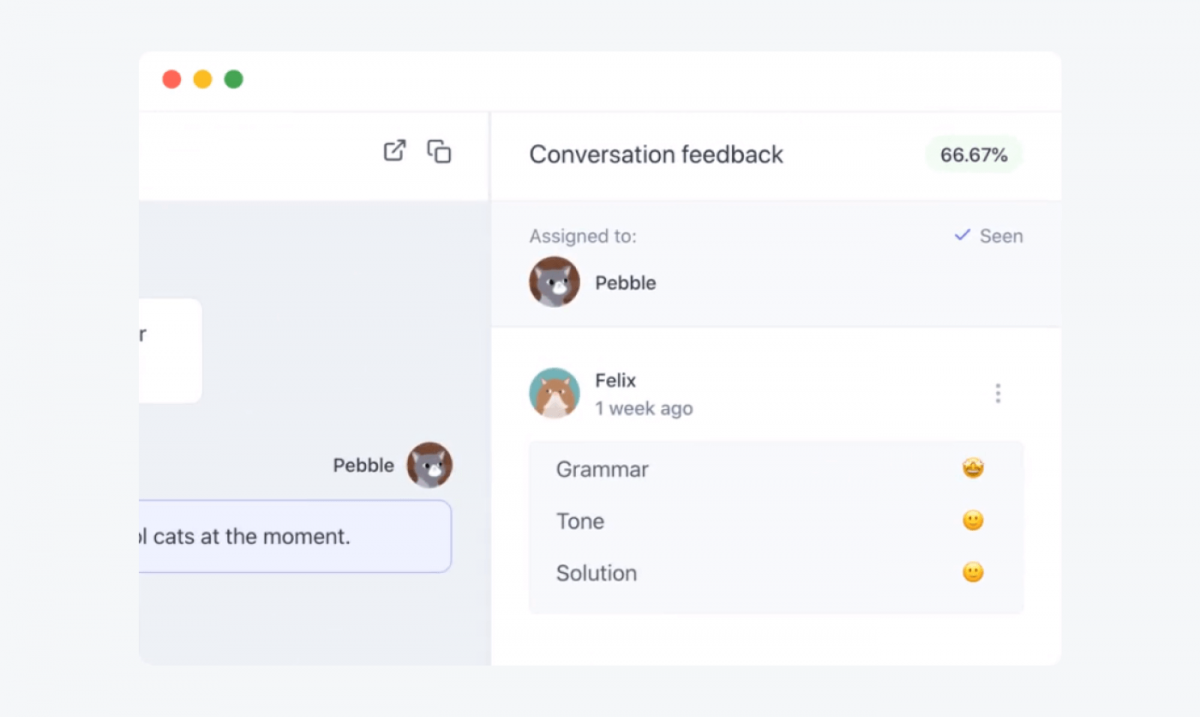
Collect some transcripts of conversations with your customers. Share them with your team. Ask them to identify what went right, wrong, and what should be done in a given situation. You can create your internal customer service knowledge base for employees based on the results.
Be careful!
Some people hate being evaluated or judged. They may think that reviewing their conversations during a workshop would be humiliating. Try to prepare them mentally and don’t do this exercise if your team does not want it.
3. Role-playing
Role-playing and scenario-based activities are the primary type of workshops you can do with your employees. It is also one of the most powerful ones. Customer service role-playing training can bring your team’s problem-solving skills to the next level.
Consider training scenarios based on dealing with difficult or unusual customers.
Example customer service scenarios for training:
- Customer who swears
- Customer who tries to flirt with you
- Customer who wants to trick you into giving a discount
- Scammer or joker who only pretends to be a customer
- Product user who keeps asking about obvious things
This type of training works great with online tools. Sometimes it is difficult to keep a straight face if coworkers need to role-play in front of others. But with live chat, you can experiment with role-playing scenarios anonymously. It is also easier to analyze chat conversation scripts and give feedback afterward.
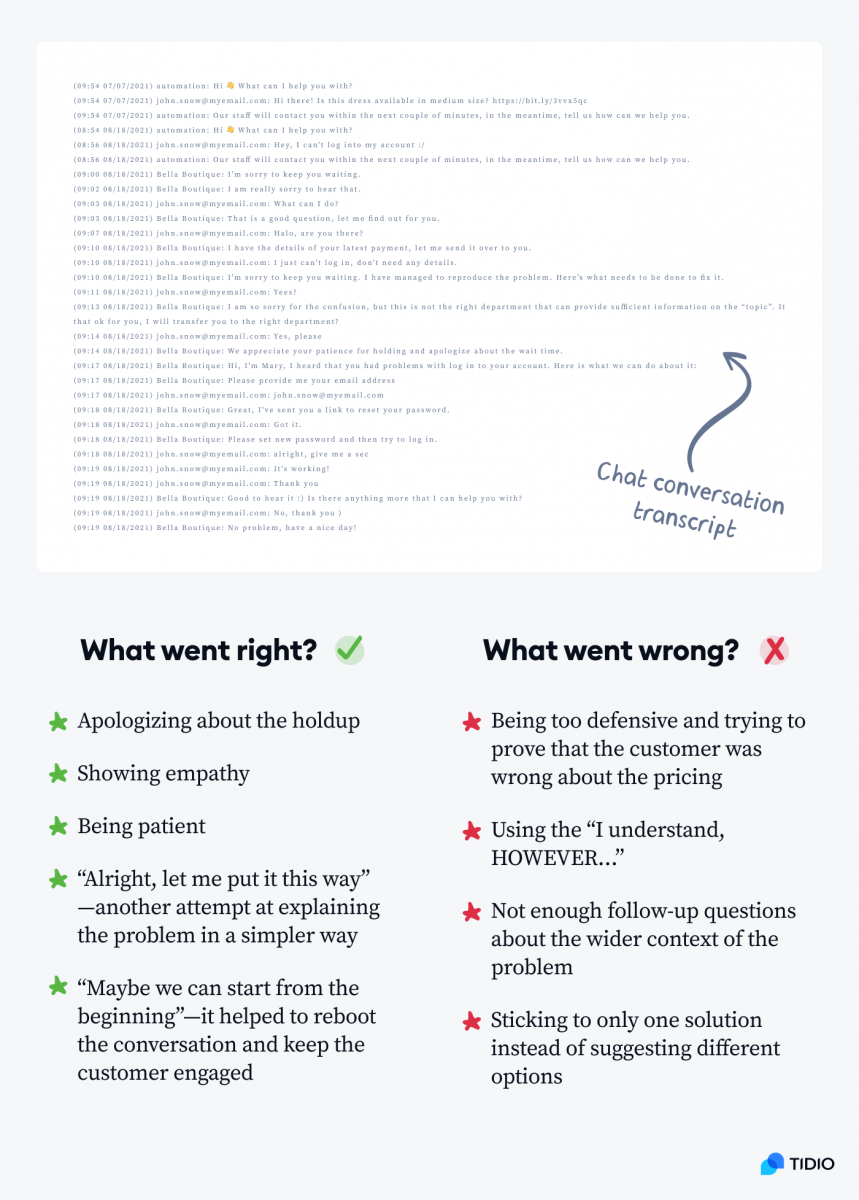
4. Crisis management
Divide your employees into two or more teams. Each team should receive the same description of a crisis situation. It should be a major problem with no straightforward solution. And it doesn’t even have to be customer service related.
Make them discuss the possible solutions and prepare a plan. Then compare their ideas and make them justify their choices.
This exercise will give you many insights into the relations between your employees. Observe who takes the initiative and is a natural leader.
5. Personality tests
The CliftonStrengths assessment and other personality tests are fun and good for teambuilding. It is a great opportunity to learn more about your team members and their talents.
Before sharing the results try to play a little guessing game. Once everyone gets their results, let team members try to predict what are the dominant personality traits or talents of others.
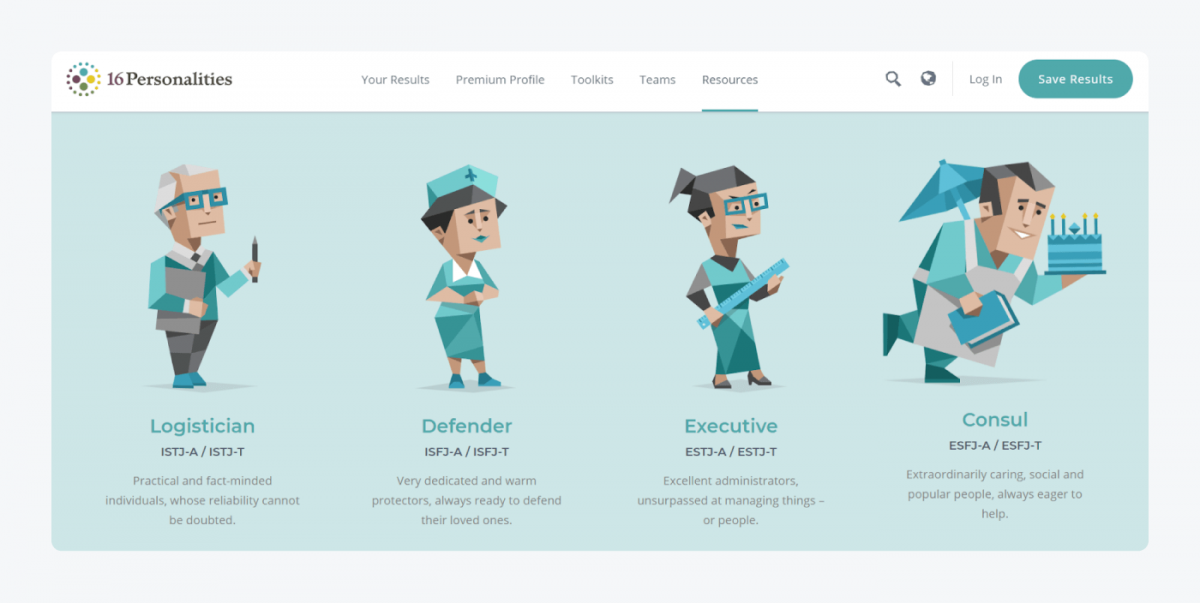
You can also use free personality tests:
6. Joke complains
Make your customer service reps imagine the most ridiculous customer complaints. The complaints should be related to your industry and very specific. Most businesses get ridiculous customer requests from time to time. Try to prepare a list of these complaints and rank them.
Examples
- Why is this ice cream so cold? Can you do something about it?
- I’ve been wearing these shoes for two weeks only. Why can’t I return them?
- I’ve watched the whole movie. But it was terrible. Can I get a refund for my ticket?
After the list is complete, try to estimate how probable the situations may be. Use these “absurd” customer requests for role-playing. Focus on practicing the nightmare scenarios that could potentially happen. This customer service game is good preparation for the worst things that could happen. And some of them probably will!
7. Cross-team collaboration
It is a good idea to organize a customer service workshop that involves other departments. For example, you can invite people from your marketing or UX team to join in.
Switching positions can give your employees a new perspective. You’d be surprised how many insights and ideas this type of collaboration generates. Different teams within a company are frequently unaware of issues that other departments are facing on a day-to-day basis.
Spending a day as a customer service agent can be an eye-opening experience for your designers or marketers. It will help them perform their jobs with customers in mind.
Read more: Encourage your customer service team to take a typing speed test and see how fast they can reply to customer queries.
Best customer service training programs (with certificates)
Every company wants to provide great customer service. But organizing a training session can be complicated. If you just want to make sure that you or your team covered the basic topics, there are many online courses available.
Here is a selection of great customer service training programs. You can access them online but some offer in-person training too. Visit the websites for more details.
Courses vs practical experience
Completing a course or customer training program doesn’t automatically make you a good employee. A deep understanding of the products that you offer and your experience with customers is much more important.
Disney’s Approach to Quality Service (Disney Institute)
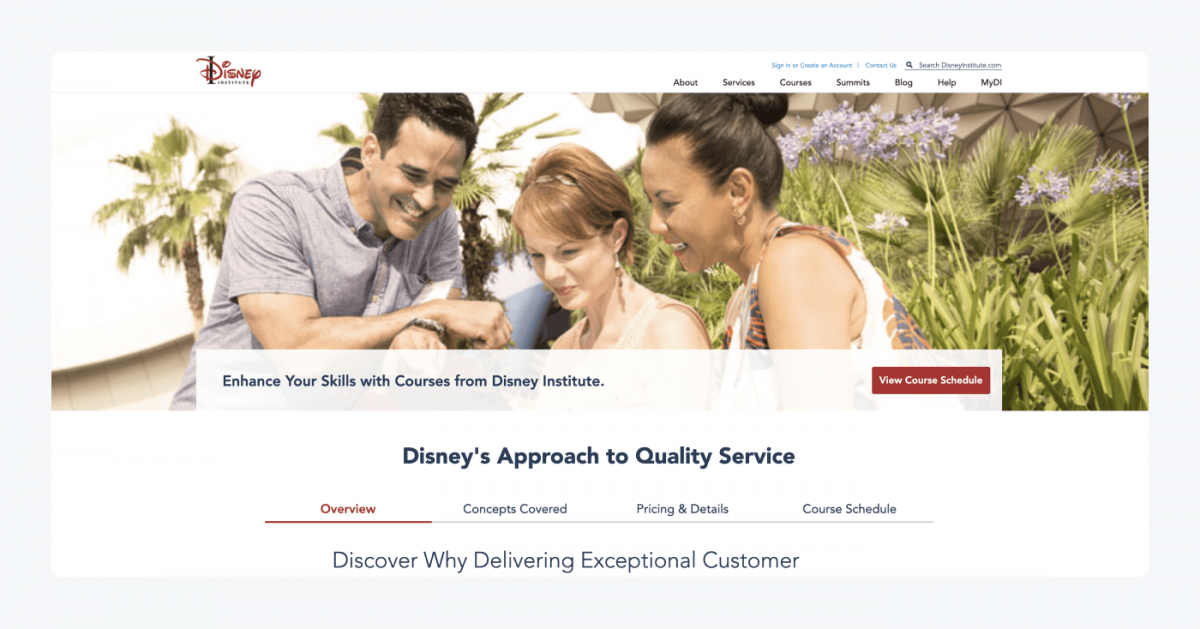
Disney’s approach to customer service is legendary. The company is famous for going the extra mile to keep its customers satisfied. If you want to learn from the absolute best, sign up for a customer service training program prepared by Disney Institute.
The training covers:
- Identifying the current state of customer service quality within a company
- Designing a customer service strategy to improve customer experiences
- Recovering for failures and customer service mishaps
It is an on-demand course. The basic version costs approximately $1,500-1,750 and lasts one day. It is not one of the cheapest customer service programs available but it’s worth it.
Customer Service Mastery: Delight Every Customer (Udemy)
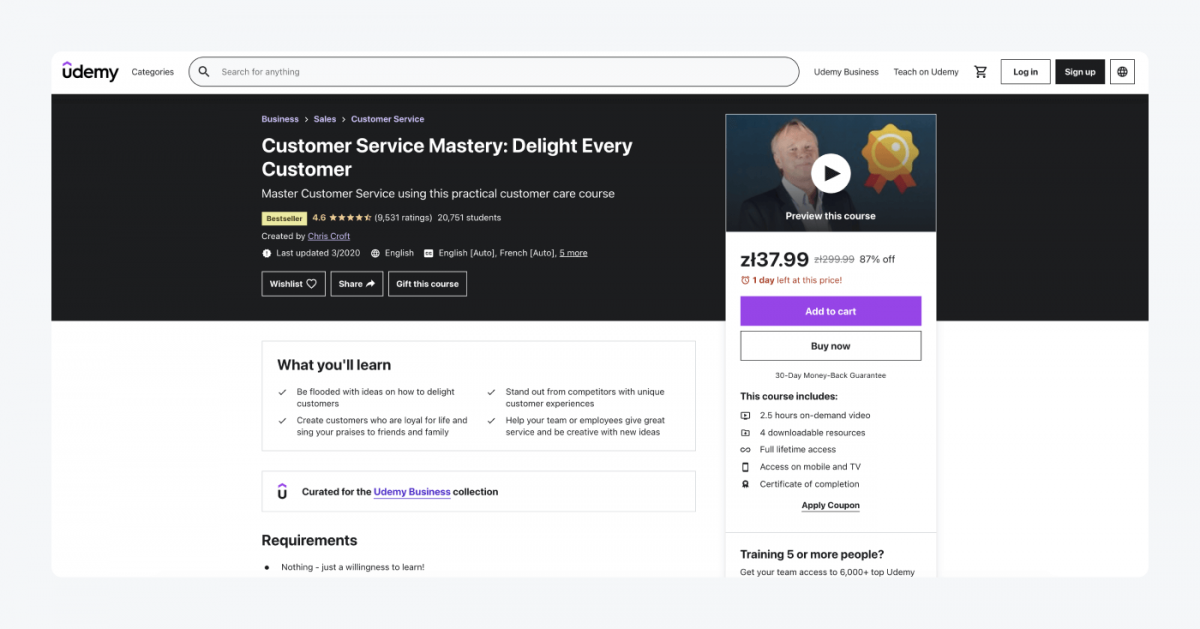
This course by Chris Croft is one of the most comprehensive and actionable customer service training online courses. Udemy has many other courses on customer service but this one is the all-time favorite.
Watch it to learn:
- How to create “customer care delights”
- How to motivate customer service representatives
- What are the most common missed opportunities for improving customer service
- How to increase customer loyalty and maximize your profits
It is 150 minutes long and the amount of knowledge crammed into the course is astounding. It costs $99,99 but if you are a new user you can get a discount and buy it for $17,99.
Free Online Customer Service Training Course (Alison)

If you don’t want to spend too much money, here is a good alternative for you. This course by Alison was prepared with beginners in mind. You can cover the material in approximately 2 hours.
It consists of the following customer service training modules:
- How to understand customers
- Focusing on customer needs
- Phone customer service
- Handling customer complaints
- Stress management for customer service employees
The course and customer service training materials are free. However, to get a service training certificate you need to pay for the assessment and downloadable/physical/printable certificate.
Culture of Services: New Perspective on Customer Relations (edX & Kyoto University)
This course may seem to be slightly more academic than typical customer service training seminars. But don’t be deceived—it is very actionable and uses many real examples… straight from Japan. Yes. As it happens, it was prepared by Kyoto University.
“Culture of Services” takes a broader look at customer service in the context of sociology and philosophy. If you want to learn why there are no menus in the best sushi restaurants, this is a course for you.
It has almost 5 hours of the main workshop video materials. There are also additional customer service exercises and resources. The course is free but if you want to receive a certificate you need to pay $49.
Need help with managing your team's progress?
If you want to keep track of new skills and training completed by your team, there is software for that. Learning management systems (LMS platforms) are becoming quite popular. Google Classroom is the best free LMS solution.
Customer service training manuals and other resources
Transcripts of actual conversations with your customers are your best training materials. You should add a live chat to your website and start collecting them immediately.
However, if you need something more general, here is a selection of customer service training manuals and other useful resources.
The core ideas from the Disney customer service training manual
- Never Let Backstage Come Onstage
- What time is the 3:00 Parade? It is not a stupid question.
- Little Wows Add Up
- Have Fun with the Job No Matter How Miserable You Feel
- Don’t be a Customer Service Robot
- Pay Attention to the Details—Everything Speaks
- Never Ever Say, “That’s Not My Job”
- Everyone Has a Customer
- Figure Out What Ticks Off Your Customers—and Do Something About It
- Take Responsibility for Your Own Career
Source: Lessons From the Mouse: A Guide for Applying Disney World’s Secrets of Success to Your Organization, Your Career, and Your Life by Dennis Snow
More customer service training resources:
- Best Support Phrases and Quotes for All Types of Customer Service
- Dale Carnegie Quick Tips for Outstanding Customer Service
- Chick-fil-A Customer Service Training Manual and Standards
- 15 Examples of Tricky Customer Service Conversations
- Customer Service Training Manual Template from HubSpot
- Free Customer Service Training Manual from Lessonly
Key Takeaway
Some customer service employees go about learning the necessary skills through pure practice. As they get more experience they will know how to approach all types of customers.
But some customer service reps may need extra help. An in-house product training or an online course is always a good idea. Still, you don’t have to enroll in the most expensive training program to become a great customer service agent. There are many free customer service courses available, like the ones mentioned above.
The biggest benefits of all types of customer support training are:
- Better business results through increased customer satisfaction
- Improved understanding of products offered by your business
- Delivering high-quality customer experiences
- Being able to help customers solve their problems with more efficiency
- Learning more about yourself, your colleagues, or employees
We highly recommend using Tidio for learning chat-based customer service. Regardless of whether you choose to go with a short training organized within your organization or a certified program. The app allows you to get the first-hand experience of dealing with customers in real-time.
Learn how to use AI chatbots to boost your sales
